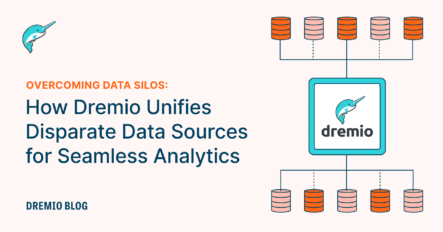8 minute read · January 18, 2024
Overcoming Data Silos: How Dremio Unifies Disparate Data Sources for Seamless Analytics
· Head of DevRel, Dremio

Effective management and utilization of data are crucial for the success of any business. However, one significant hurdle that many organizations face in their quest to become data-driven is the prevalence of data silos. Data silos occur when information is isolated in separate departments or systems within an organization, making it inaccessible or invisible to other parts of the business. This data compartmentalization hinders collaboration and knowledge sharing, leading to inefficiencies and a lack of coherent insight.
Enter Dremio, a solution designed to break down these silos, unifying disparate data sources for seamless analytics. It enables the business to combine varied data sources, from traditional databases to modern cloud storage systems, into a single, coherent, and accessible analytics environment. This blog explores how Dremio achieves this feat and why it's a game-changer for businesses looking to leverage their data more effectively.
Understanding Data Silos
Data silos are essentially isolated pockets of data stored in separate systems or departments within an organization. These silos can be the result of historical organizational structures, disparate technology systems, or even cultural barriers within the company. The key characteristics of data silos include limited access, where only specific groups or departments can access the data, and lack of integration, where the data is not linked to other relevant data within the organization.

The Root Causes
Several factors contribute to the formation of data silos:
- Organizational structure: Companies with rigid departmental divisions often end up creating data silos, as each department generates and stores its data independently.
- Diverse technologies: Different technologies and platforms across departments can lead to compatibility issues, making data integration challenging.
- Cultural barriers: Sometimes, the issue is less about technology and more about the mindset, where departments are hesitant to share information due to competition or lack of trust.
The Impact of Data Silos
Data silos can have a detrimental impact on an organization’s ability to make informed decisions. Key issues include:
- Inefficiency and duplication: When data is siloed, the same data may be collected and stored multiple times across the organization, leading to inefficiencies and increased costs.
- Impaired decision-making: Silos prevent a holistic view of the organization's data, leading to decisions based on incomplete information.
- Reduced agility: In today’s fast-paced business environment, the inability to access and analyze data quickly can hinder an organization's ability to respond to market changes.
What Is Dremio?
Dremio is a data lakehouse platform designed to combat the challenges posed by data silos. It is a data unification solution, enabling high-speed data access and manipulation across various data sources while also operationalizing your data lake into a full-blown Apache Iceberg lakehouse. Dremio stands out for its ability to integrate disparate data repositories without the need for data movement or duplication, fostering a more efficient and agile approach to data analytics.

Key Features of Dremio
- Data virtualization: Dremio allows for data virtualization, meaning it can connect to various data sources and provide a unified view without physically moving data.
- Self-service data access: It democratizes data access, enabling end users and analysts to retrieve and analyze data independently, reducing reliance on IT teams. Dremio also features a robust semantic layer.
- Advanced query acceleration: Dremio incorporates sophisticated query acceleration techniques, significantly reducing the time required to process complex queries.
How Dremio Unifies Data Sources
Dremio’s approach to unifying disparate data sources involves several key strategies:
- Direct data source connectivity: Dremio can connect directly to various data sources such as SQL and NoSQL databases, cloud storage, and file systems, creating a cohesive data environment.
- Querying across sources: It enables querying across these different data sources, facilitating complex analytics without data consolidation or movement.

Enhancing Analytics with Dremio
Dremio simplifies and accelerates data analysis by:
- Integration with BI tools: Dremio seamlessly integrates with popular business intelligence tools, enhancing their capabilities by providing access to a broader range of data sources.
Advanced Features of Dremio for Seamless Analytics
Dremio is equipped with several advanced features:
- Query acceleration with data reflections: Data reflections create optimized data representations, speeding up query performance.
- Robust security features: Dremio ensures data security through features like encryption, access controls, and compliance with industry standards.
- Scalability and flexibility: Designed to scale with the growing data needs of an organization, Dremio supports both on-premises and cloud deployments.
Getting Started with Dremio
Step 1 - Try Dremio out on your laptop using Docker and get a feel for the ease of use of the platform.
Conclusion
Dremio stands as a formidable solution to the pervasive challenge of data silos. Unifying disparate data sources enables organizations to leverage their data assets fully, enhancing decision-making and operational efficiency. As the data landscape evolves, tools like Dremio will be critical in shaping a more integrated and insightful approach to data analytics.
Sign up for AI Ready Data content


